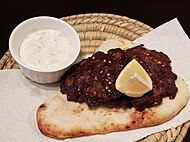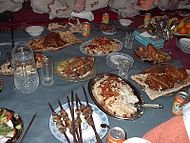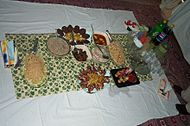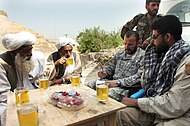Pashtun cuisine
This article relies largely or entirely on a single source. (April 2020) |

Pashtun cuisine (Pashto: پښتنۍ خواړه) refers to the cuisine of the Pashtuns. The cuisine of the Pashtun people is covered under Afghan cuisine and Pakistani cuisine, and is largely based on plethora of meat dishes that include mutton, beef, chicken and fish as well as rice and some other vegetables.[1] Accompanying these staples are also dairy products (yogurt, whey, cheeses), including various nuts, locally grown vegetables, as well as fresh and dried fruits. Cities such as Peshawar, Jalalabad, Khost, Kabul, Kandahar, Quetta, Mardan and Islamabad serve as centers of Pashtun cuisine.
Dishes[]
The following is a short and incomplete list of some food items that Pashtuns often eat.
- Kabuli palaw
- Pekhteh or Pukhtay (beef/mutton ribs)
- Naray ghwakha (mutton, mutton dish)
- Chopan Kabab (lamb chops, skewered and grilled on charcoal)
- Seekh kabab (beef/mutton/chicken)
- Chapli kabab
- Shinwari tikka, roasted lamb
- Kichrei, sticky medium grain rice cooked with mung beans and onions, topped with melted qurot sauce. This is mostly eaten during winter.
- Londei (aka Tarshay), (spiced lamb or beef jerky cooked with rice)
- Shorwa (soup)
- Aush (hand made noodles)
- Aushak (vegetable and chive-filled dumplings topped with tomato and yogurt sauces)
- Mantu (meat dumplings), usually served under a yogurt-based white sauce
- Bolani also called Piraki in Afghanistan
- "Kaddo Borwani, baby pumpkins pan fried and then baked and served with garlic and yogurt,"[2] not to be confused with Bolani.
- Bonjan, eggplant cooked in oil with potatoes and tomatoes
- Bendei, okra cooked in oil with onions and tomatoes. Also known as Bhindi in Urdu/Hindi.
- Masteh (freshly made yogurt)
- Ghatay Rujay (Ghatay Wrejay), literally "fat rice", is a rice dish, resembling risotto, prepared in Charsadda, Mardan, Pirpiai, and some other villages of the region, where the short grain brown rice is grown.
- Afghani naan or Dodai, a flat bread usually made in vertical clay ovens called Tanoor in Pashto (Tandoor in Urdu/Hindi).
- Shomleh/Shlombeh (aka "Triwai" in Kabul), a drink made from mixing yogurt with water and shaking it extensively. Then adding dried mint leaves (optional) and small amount of salt.
- Pashtun cuisine

Chapli Kabab, by Chef Nina at Nina's Desi Kitchen (Southington, CT)

Men eating lunch in Kunar Province of Afghanistan

Pashtun dinner sitting on dastarkhan in Helmand Province of Afghanistan, with U.S. troops (in the background)

Roasted chicken is popular in Pakistan and Afghanistan

Naan (bread) is widely consumed in Afghanistan and Pakistan

A typical Peshawari dinner course, with various dishes

Village elders and US special forces drinking Afghan green tea (kawa) in 2007
Traditional breakfast items[]
Pashtuns residing in their traditional territory drink green or black tea (chai) with their breakfast meals. Some drink masala chai, especially the Pakistani Pashtuns. Sheer chai, also known as Kashmiri chai, is also consumed by the well-off Pashtuns in Afghanistan. Their breakfast include Afghan naan, paratha, eggs, butterfat, milk creams, cheeses, etc. Pastries, cakes and cookies are also consumed with either tea or warm milk. Those residing in cities buy and eat whatever breakfast items are sold in grocery stores, which may include porridge, oatmeal, cereal, pancakes, sausages, fruit juices, etc.
See also[]
- Afghan cuisine
- Pashtun culture
- Pakistani cuisine
References[]
- ^ https://www.tastecooking.com/the-end-of-afghan-cuisine-in-pakistan/
- ^ "Exile on Charles Street: Restaurateur Qayum Karzai's life is split between Baltimore and his native Afghanistan". Baynard Woods. The Baltimore Sun. 3 March 2015. Retrieved 2021-12-28.
- Pashtun cuisine
- Afghan cuisine
- Pakistani cuisine
- Pashtun culture
- Cuisine by ethnicity








